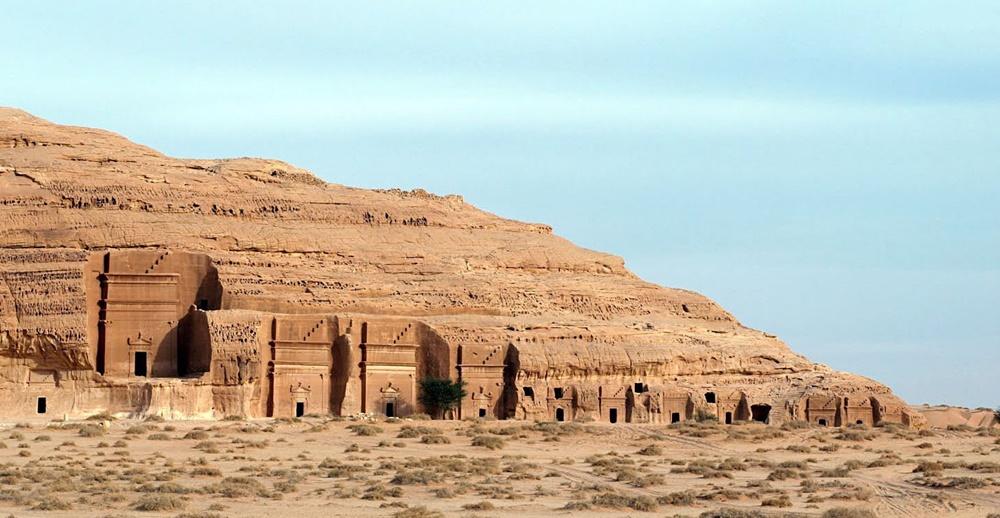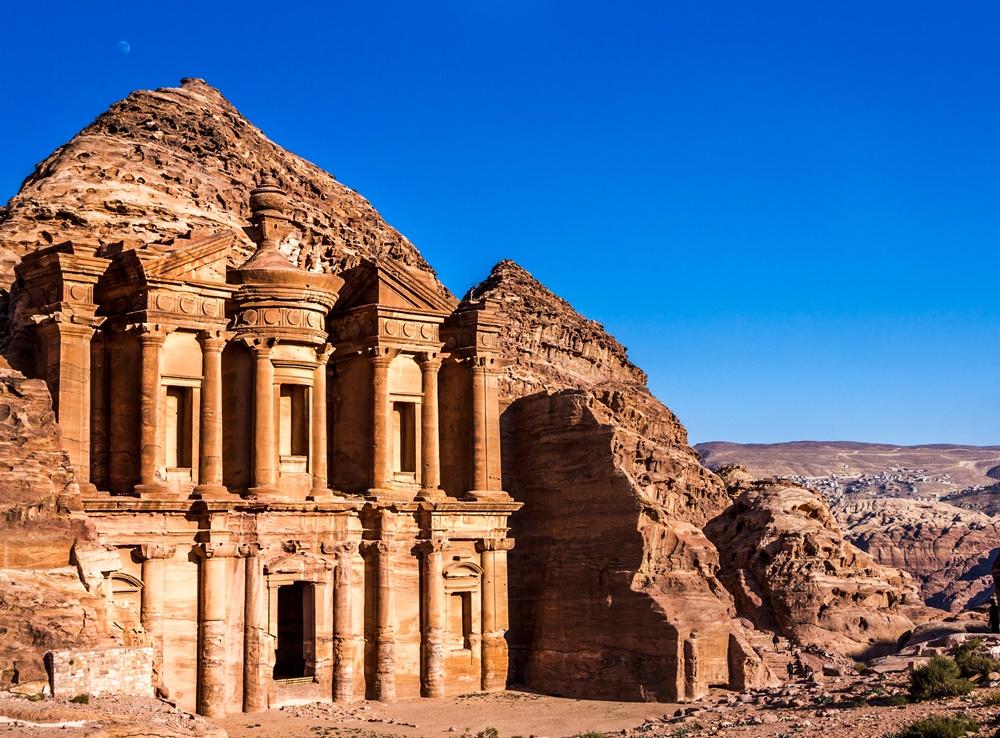Located 400 km from al-Madinah al-Munawarah is Mada’in Saleh where the remains of a once wealthy and powerful people called Thamud lie still in an uninhabited desert. Allah destroyed them for their shirk, corruption and rejection of Prophet Saleh.
They erected huge buildings on the plains and carved beautiful houses out of the dense rock of the mountains.
And Thamud (people), who hewed out rocks in the valley (to make dwellings) [Qur’an, 89:9]
To guide them to the right path, Allah sent Prophet Saleh, a man from among them. Prophet Saleh called his people to worship Allah alone, not associate partners with Him, and not obey the transgressors. Saleh said:
“And remember when He made you successors after ‘Ad (people) and gave you habitations in the land, you build for yourselves palaces in plains, and carve out homes in the mountains. So remember the graces (bestowed upon you) from Allah, and do not go about making mischief on the Earth.” [Qur’an, 7:74]
However, the people of Thamud ignored his calls and warnings as obsession with materialism took over. They felt proud of their accomplishments and felt safe within their magnificent structures.

As Prophet Saleh’s followers increased, the Thamud asked for a seemingly impossible miracle to prove that he was indeed a messenger of Allah. They pointed at a rock and asked him to bring forth a she camel that was extremely tall, attractive and ten months pregnant.
“You are but a human being like us. Then bring us a sign if you are telling the truth.” [Qur’an, 26:154]
Prophet Saleh prayed to Allah to grant their request and from the rock emerged a she-camel with the said characteristics. Yet many still continued in disbelief, stubbornness, and haughtiness.
Their hatred for Prophet Saleh turned towards the she-camel. Fearing that they may harm it, Prophet Saleh warned his people. He said: “Here is a she-camel: she will have her share of water and you will have your share, each on an appointed day. Do not harm her in any way, lest the punishment of a momentous day overtake you.” [Qur’an, 26: 155-156]
For a while, the people of Thamud let the camel graze and drink freely. But seeing the increase in Prophet Saleh’s followers, they killed it out of spite and haughtily mocked him to hasten the punishment of Allah.
So they killed the she-camel and insolently defied the Commandment of their Lord, and said: “O Saleh! Bring about your threats if you are indeed one of the Messengers (of Allah).” [Qur’an, 7:77]

Prophet Saleh told them that their punishment would come in three days, giving them time to repent.
But they killed her. So he said: “Enjoy yourselves in your homes for three days. This is a promise that will not be belied.” [Qur’an, 11:65]
Instead, they began plotting to kill Prophet Saleh too.
And there were in the city nine men (from the sons of their chiefs), who made mischief in the land, and would not reform.
They said: “Swear one to another by Allah that we shall make a secret night attack on him and his household, and thereafter we will surely say to his near relatives: ‘We witnessed not the destruction of his household, and verily we are telling the truth.'”
So they plotted a plot, and We plotted a plot, while they perceived not. [Qur’an, 27: 48-50]
Allah ordered Prophet Saleh and his followers to leave the town. After the given time was over, an earthquake shook the land violently and destroyed the people of Thamud in one cry.
And As-Saihah (torment – awful cry) overtook the wrong-doers, so they lay (dead), prostrate in their homes,
As if they had never lived there. No doubt! Verily, Thamud disbelieved in their Lord. So away with Thamud! [Qur’an, 11: 67-68]
Then see how was the end of their plot! Verily! We destroyed them and their nation, all together. These are their houses in utter ruin, for they did wrong. Verily, in this is indeed an Ayah (a lesson or a sign) for people who know. [Qur’an 27: 51-52]
Ibn Umar narrated that while Prophet Muhammad ﷺ was passing by Thamud’s houses on his way to the battle of Tabuk, he stopped together with the people there. The people fetched water from the wells from which the people of Thamud used to drink. They prepared their dough (for baking) and filled their water skins from it (the water from the wells). The Prophet of Allah ﷺ ordered them to empty the water skins and give the prepared dough to the camels. Then they moved on till they reached the well from which the she-camel (of Saleh) used to drink. He ﷺ ordered them to use the water from that well. He warned them against entering upon the people that had been punished, saying “Do not enter upon these people who are being punished, except in a weeping state, lest the same calamity as of theirs should befall you.” (Sahih Bukhari)
Archaeological dating and when the Thamud actually lived


The Qur’an places Prophet Saleh and his people between the time of Prophet Hud and that of Prophet Ibrahim, which can be many thousands of years ago. According to archeologists, the popular UNESCO heritage sites at Mada’in Saleh (also known as Al-Hijr or Hegra) belong to a people who lived much recently, around the first century (1CE). The oldest known reference to “Thamud” is a 715 BCE inscription of the Assyrian king Sargon II, which mentions them as being among the people of eastern and central Arabia.
So, does this cast a doubt on what the Qur’an and Sunnah mention? No. There are responses and evidences to clear this misunderstanding.
1. Usage of the name Thamud
According to classical sources, the name “Thamud” applied to the region or land as well. Therefore, it was not restricted for the people that Prophet Saleh was sent to. People who lived in the same region after those who were destroyed were also likely called by the same name. The narration of ʿAbdullah ibn ʿUmar and analysis of Ibn Kathir report that people called the region of Thamud Al-Hijr, while they called the province of Mada’in Salih as Ardh Thamud (Land of Thamud) and Bayt Thamud (house of Thamud). The historian Robert Hoyland therefore suggests that the name was subsequently adopted by other groups who inhabited the region.
Early Islamic scholars also mention that the only remaining group of the native people of Thamud are the tribe of Banu Thaqif, which inhabited the city of Taif.
2. Limitations of archaeological dating
Current scientific methods to estimate a time period are not fool proof. There are several limitations, which can quite significantly alter the results. So, we cannot be completely sure if the dating of a particular site is exact. In one example, researchers trying to understand the limitations dated an old bristlecone pine tree at being 5,000 years old. But, using other evidence, they put the estimate of the same tree at being nearly 14,000 years old. As we further progress, we do not know what we will come to learn in the future that may render many of our current archaeological assumptions obsolete.
In conclusion, we know for sure that what the Qur’an says and what is authentically reported from the Prophet ﷺ cannot be wrong. Alhamdulillah, this has been the case time and time again when people came up with seeming contradictions. But the challenge of the Qur’an holds true till date and will remain so until the Day of Judgment.
Then do they not reflect upon the Qur’an? If it had been from [any] other than Allah, they would have found within it much contradiction. [Qur’an, 4:82]
The Nabateans


According to archeologists, the last known civilization that lived in Mada’in Saleh was the nomadic Arab Nabataean kingdom dating back to the first two centuries. If this is the case, they came much after the people of Thamud mentioned in the Qur’an. The Nabataean civilization eventually fell into decline following Roman conquests in 106 CE. However, the region continued to serve as an important location for cultural and intellectual exchange up until the 4th century CE.
Mada’in Saleh, also known as al-Hijr (Hegra), was like a second capital (after Petra in Jordan) which controlled several trade routes of the region, amassing large wealth and drawing the envy of its neighbors.
The people were skilled in craftsmanship, trade, construction, and hydraulic engineering. They carved monumental houses and tombs, whose architecture and decorations were directly cut into the sandstone. They also built a sophisticated water management system to preserve and use their water resources.

A Nabatean monastery in Petra, Jordan.
In the present day, one can find ruins of 111 monumental structures, among which 94 were decorated with majestic facades on the sandstone massifs of the area, especially the Jibal Ithlib. The smallest tomb is barely 2.7 meters tall but the biggest reaches an impressive 21.5 meters.
The monumental tombs were reserved for the elite of the city for whom it was a way to display their importance and status. The rest of the population was buried in tombs dug in the ground, sometimes even on the rock.
Two thirds of the tombs have a cartouche above the door containing a text in Nabatean script. Those inscriptions are judicial documents giving the name of the owner of the tomb, naming the persons having the right to be buried. Interestingly they also indicate a date showing that all the monumental tombs were dug between 1 and 75 CE. Allah knows best.
References:
– The Detailed History of Arabs before Islam, Prof. Jawwad Ali, Volume: 15, Page: 301
– The Historical Record of Ibn Khaldon, Volume: 2, Page: 641
– Kitab Al-Aghani, Abu Al-Faraj Al-Asfahani, Volume: 4, Page: 74
– Ibn Kathir (2003). Al-Bidâya wa-l-Nihâya (“The Beginning and the End”) Vol.1. Beirut: Dar al-Kutub al-Ilmiyya. p. 159.
– Sahih al-Bukhari, Narrated: ʿAbdullah ibn ʿUmar, Hadiths: 2116 & 3379
– Cited from Wikipedia
– Jones, N. (2020, May 19). Carbon dating, the archaeological workhorse, is getting a major reboot. Nature News. Retrieved March 14, 2022, from https://www.nature.com/articles/d41586-020-01499-y








 Dr. Bilal Philips
Dr. Bilal Philips